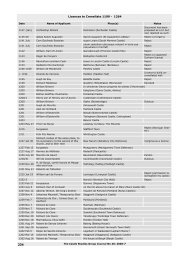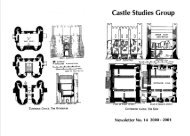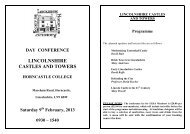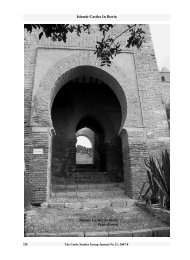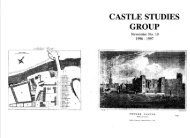Machicolation: some postscripts. - Castle Studies Group
Machicolation: some postscripts. - Castle Studies Group
Machicolation: some postscripts. - Castle Studies Group
Create successful ePaper yourself
Turn your PDF publications into a flip-book with our unique Google optimized e-Paper software.
<strong>Machicolation</strong>: <strong>some</strong> <strong>postscripts</strong>.Fig. 9. Lanuvio. Early 15th century tower, built possiblyby developing a Roman tower.Equally interesting and perhapsclearer in what it tells us is a tower ortorrião at Azemmour in Morocco built bythe Portuguese in about 1515 (Fig. 10). Ithas a flattened oval plan and machicolationthat both harks back to Château Gaillardand forward to the forts at Genoa and theMartello towers at Pembroke Dock. Alsoincorporated into the tower are small armsslits and very large cannon ports. The toweris without batter and the machicolationis formed of what might be described aschutes, perhaps a metre and a half long thatdie back into the thickness of the tower,rather than being engineered by a bracketing-outabove them; the form is rather likethe reverse side of a cheese grater. This isdifferent from any design of machicolationpreviously built.It is an odd piece of design: machicolationcontinues to be used at quite a latedate, but is remodelled. Remodelling suggeststhat even as late as this, <strong>some</strong>thinglike machicolation was the close defencedevice of first choice for <strong>some</strong> people andit had not become merely symbolic anddecorative; this does not even look likeearlier versions of machicolation. It may bethat the building material available in Moroccoprecluded the use of corbelled machicolation,even of the structurallyundemanding type we see at Soncino andMondavio. 12 Mortar made from the locallime was considered to be too brittle - thePortuguese imported massive amounts oflimestone for burning - and may not haveallowed the use of cantilevers, but it may bethat this is a thoughtful reassessment quiteunconnected with constructional problems,of what a small arms gunport needs to be ifit is to defend the approaches to a tower orwall, foreshadowing, as hinted, the latere-use of machicolation in the nineteenthcentury.Handguns (and at this date, stillcrossbows) must surely be what this machicolationwas intended for: missilesdropped vertically through the openingshere would only roll down the slopingchute and would have been very inaccurate.Moreover, one can see up through themachicolation openings from locations onthe ground <strong>some</strong> distance from the tower,strongly suggesting a line of fire reachingthat far. The Portuguese call this devicevãos para tiro mergulhante - “holes forplunging fire,” a phrase that confirms, inthe use of the word tiro, an assumption thatshooting is what this machicolation wasused for. This design of machicolation actuallymakes it very difficult to cover thebase of the tower but it does lessen thevulnerability of machicolation to destructionby gunfire. In fact, this tower is at are-entrant angle of the curtain wall and itsbase can be swept from the wall. This doesnot apply to other parts of the town withThe <strong>Castle</strong> <strong>Studies</strong> <strong>Group</strong> Journal No 24: 2010-11 222



